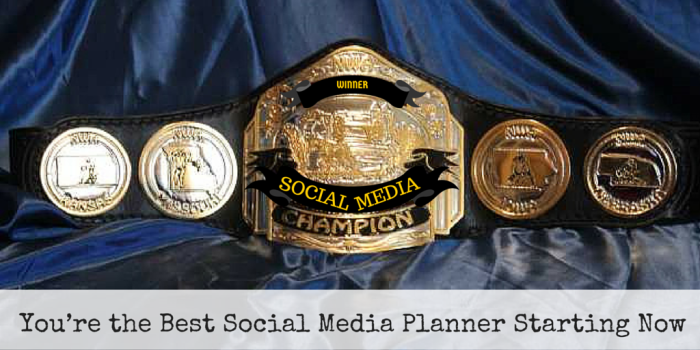Blog
You’re the Best Social Media Planner Starting Now

It may be hard to accept, but January is over man. Let it go. February is upon us. In fact, the results of your February work are being logged as you read this. If that makes you a little uneasy, it may be your weak social media plan unfurling your confidence. Perhaps I’m shoehorning an agenda here, but let’s talk about your social media plan anyway. It’ll be exciting.
Before we dig in, we’re gonna talk about this as if February didn’t start yet. It’s way too early to stress March. Plus, if you’re reading this, you probably could use some February help. The good news is, it’s a leap year so you have an extra day to make it rain. Let’s get you some stellar social media results, but first let’s talk about how.
In order to plan properly for February, you will need to report the outcomes of your January efforts in a report, compare those reports in relation to the current overall goals for social media, outline your new plan, then execute it.

Report your results.
Whether you use Google Analytics, Piwik or some other form of data collection, you’ll need to collect all your data in one place. If you’re working for a small organization you will likely be the one to organize it.
First, let’s organize your analytics. There are two ways you can go about this. Search the world wide web for an existing template in which to record your data or create your own. Let’s assume for the sake of argument you are in your position because you are competent enough to create a spreadsheet. We recommend you organize your data by month and track it for the year. Later you can create tabs for the years as they pass by.
If this is the first month you’ve collected this data, try to pull as much historical data as you can. It will help in later steps. At the very least, try to collect last month and last year’s data. Include progress for all of your social media streams with, impressions, engagement, clicks through to the website, and conversions.
You also need to add data. Hopefully, your company isn’t so small that they’ve missed the value of social advertising. In the big world of online marketing, advertising on social media hasn’t tipped the paid search scales yet. This much is true. Some people still travel via horse and buggy. Who are we to judge or snicker behind anyone’s buggy back?
Here’s the difference: Paid search uses cookies, a leftover technology from the early days of the internet. In a nutshell, cookies are weak. If the users don’t disable them, the most they can do is gather general demographic information. That’s just the way it’s been done.
With social advertising, companies like Facebook can track individual users with robust psychographic data using unique user IDs. We’re only a few lines of code away from making ads that call out a user’s name, “Hey Nick, come buy this awesome thing?” But I digress…
Whatever ads you ran last month, you need to collect all the data you can. Social sites like Facebook, Instagram and Pinterest have rolled out codes you can install on your site, which allow you to better track your social ad campaigns.
If you haven’t set yours up yet, get mom and dad to help you, or get the IT guy. You’ll learn a lot more about the success of your ads once this is done. If it is already installed, then you know what we’re talking about. Collect your data like a pro. Drop it into your spreadsheet. At the very least, you’ll want to gather impressions, clicks through to the website, transactions, and revenue.

Compare those reports with your plan.
Get quiet. Pour a fresh cup of coffee. Once your data is all organized into one spreadsheet, it’s time to get analytical. Consider the overview and determine which areas are working well and if your goals are being met. Don’t worry yet if those goals made sense in the first place. We’ll get there next. What you should be identifying is where your users tend to drop off.
- Impressions part I. First, are users seeing your posts? If your impressions are zero, then they are not even seeing your posts. What time of day are you posting? Do you have followers? Start there. If the impressions are good, drill down.
- Impressions part II. What are they seeing most of? There are a few indicators you want to consider, like what times of day gets the best impressions? Which types of content are seen more? Which pieces of content are being engaged, via likes, comments or shares. If your followers are all about the snarky text-images you post on Pinterest, make a note for planning.
- Clicks. Ultimately it’s all about traffic. As a social media marketer, this is your bread and butter. How many people click your posts or ads?
- Conversions. If you are in Ecommerce, this is dollars. If your site isn’t selling products, then you may be measuring emails collected or sign-ups. Within the realm of analytics, conversions can be just about any action you deem worthy of a goal.
- Money. Plain and simple, how much was collected from social media efforts. If you’re just getting started, don’t worry if it’s zero. The thing about social media is it takes some time to build up steam, especially if you aren’t running ads yet. It will come.
Now you need to align the stars if you can. Take all of those results, and review them against your overall social media goals. Assess whether or not your goals are realistic. If need be, revise them for the next month.
As one possible example, if your goal for revenue is $10,000 but you’re only making $3,000, maybe it’s better to revise the goal. Instead, you could have a goal to just increase revenue every month by 10% or even 1%. When you get better, you can raise those goals.
Bear in mind that this part of the process may shed light on some ugly assumptions you had about what you thought social media could do for your brand. Many social marketers learn quickly that being a Facebook user versus being a Facebook marketer are two wholly different worlds. It isn’t shooting fish in a barrel, not at first anyway.

Plan your new month.
Now that you’ve had your coffee and identified areas that need improvement, you’re ready to plan. If the bleeding is all on impressions, then that’s where you’ll live until it gets fixed.
Hypothetically, let’s say you identify that your posts are being seen, but they aren’t being engaged. Maybe you decide that to increase engagement, you need more interesting content. Look at which posts were most successful. Go and find more content like those posts. Mix and repeat.
Try to narrow your focus to one area, with maybe a couple of bonus items if you find the time. If you try to solve too many things at once, you’ll no longer be focused. You can only truly ever focus on one object at a time. Get that one object moving, then move another one next month.

Go get ‘em, Tiger.
It’s all about execution. Creating a great plan is exciting, but you have to run that plan to make it worth the effort of drafting it.
Consider this: if you passed the excel spreadsheet test, you’re probably a little type-A. Us type-A folks love to organize. We love highlighters, red pens, filing systems, and planning. It’s a gift, but it can also be a curse. Organization matters, but only if you execute your plans.
Also, if you labor over a highly detailed plan with multiple goals and tons of strategy but fail to execute, either your plan was too busy or your execution was weak. Either way, if you have an A+ plan with D-level execution, you earn a F+, maybe an F. Create good plans for sure. Create C-level plans, but execute with A+ precision.
Review your plans and results weekly to ensure there are no huge surprises coming at the end of the month. Ideally, you won’t change your plan mid-month, but a little course correction can be critical for damage control.
If you go through all of these steps and still find your head spinning, contact us. We love planning and execution. It’s what we do all the time.
Kaitlyn Shea | Social Media Director
Categorised in: Social Media
This post was written by downtownecommerce_admin
